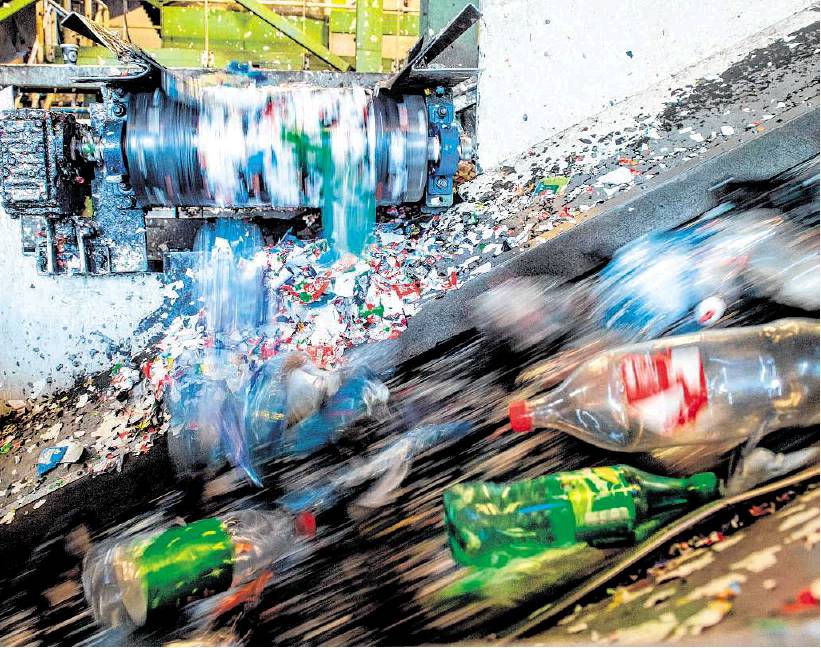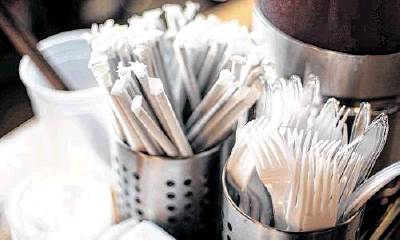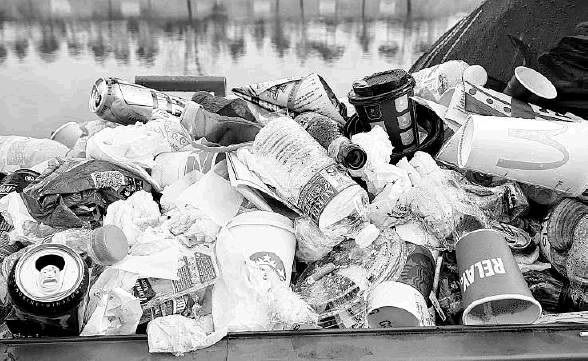SUSTAINABLE PACKAGING
Replacing plastic goes mainstream
Clogged oceans and landfills prod companies to seek alternatives
By Alexia Elejalde-Ruiz CHICAGO TRIBUNE
CHICAGO — Nicole Doucet and Jess Page were met with skepticism when they first tried to persuade retailers to sell their brand of bottled water. Consumers, the young entrepreneurs were told during those early sales calls five years ago, would not pay more for water packaged in aluminum containers instead of plastic.
It turns out their Chicago-based startup, Open Water, was just a bit early to the party. Food and beverage companies that cater to on-the-go consumers are rethinking their packaging amid growing concern about single-use plastics clogging up swaths of ocean and killing sea life, with the likes of Coca-Cola and PepsiCo launching aluminum bottled water as part of commitments to cut down on plastic usage and waste.
“It has gone very mainstream,” said Doucet, CEO of Open Water, which counts Hyatt hotels, salad chain Sweetgreen and Second City as customers.
Plastic, most of which is made from oil and natural gas, has raised particular environmental ire because half of the plastic produced globally is designed to be used just once, resulting in 300 million tons of plastic waste a year, according to a 2018 United Nations report. The top items recovered at beach cleanups are — after cigarette butts — drink bottles, bottle caps, food wrappers, grocery bags, drink lids, straws and stirrers. At the current rate of disposal, the oceans by 2050 will contain, by weight, more plastic than fish, the report said.
“As more consumers have more convenience products marketed to them, the waste becomes unmanageable,” said Ivy Schlegel, senior research specialist in plastics at Greenpeace USA.
Legislation to curb plastic waste takes aim at food producers. In Chicago, an ordinance proposed last month would ban polystyrene foam to-go containers by 2021, and disposable cutlery, drink tops, stirrers and similar single-use products would have to be compostable or recyclable and only available upon request.
At the federal level, the Break Free from Plastic Pollution Act, introduced earlier this month by House and Senate Democrats, would ban certain single-use plastic products that are not recyclable and establish minimum recycled content standards for food service products.
It also would require manufacturers of plastic products to improve, manage and finance waste and recycling programs, many of which can’t handle different types ofplastic. Just 8 percent of plastic waste in the U.S. was recycled in 2017, according to the Environmental Protection Agency, and in some cities, such as Chicago, questions have been raised about the effectiveness of recycling programs. Two aldermen this week separately called for hearings into Chicago’s recycling program and Mayor Lori Lightfoot last month announced a study of how to improve it.
Some food companies have made sustainable packaging central to their business models.
Just Salad, a fast-casual chain with 47 locations including six in Chicago, sells a reusable salad bowl for $1 and gives customers a free topping when they use it, a program that the company says diverted 75,000 pounds of single-use plastic from landfills last year. As part of a new commitment to send zero waste to landfills by 2022, Just Salad is testing compostable cutlery.
The world’s food giants are also setting ambitious waste targets.
Starbucks last month announced that by 2030 it would reduce by 50 percent the amount of waste sent to landfills, part of a broader goal to reduce its environmental footprint. Starbucks stores produce 455,000 tons of packaging waste annually, mostly polypropylene plastic used in cold cups, lids and straws.
The coffee chain is rolling out new straw-less lids for its cold drinks as it phases out plastic straws from its 30,000 stores worldwide, and in partnership with McDonald’s launched a global innovation challenge to design a more recyclable or compostable cup for hot beverages. The hot cups Starbucks now uses contain a plastic liner that makes them difficult to recycle.
In-market testing begins soon on the most viable designs.
The NextGen Cup Challenge this week also announced that acluster of independent California cafes in Palo Alto and San Francisco will test reusable cup systems that designate drop-off points around town for the cups, which are then picked up and sanitized and returned to the cafes for reuse. Starbucks for the past year has piloted such a system in London’s Gatwick Airport, but the California test examines how reusable cups might work outside of a captive space like an airport terminal.
Though corporate sustainability initiatives have been en vogue for years, plastic took center stage in 2018 when the U.K.-based Ellen MacArthur Foundation and U.N. Environment Program called on corporations and governments to sign a pledge to create a circular economy for plastics so that none is wasted. The 400 signatories of the New Plastics Economy Pledge, which include packaged foods giants such as Mars and Nestle, have announced targets to reduce plastic usage and innovate packaging to make it more recyclable, compostable or reusable.
Greenpeace’s Schlegel said some of those pledges have been meaningful.
But currently, less than 3 percent of packaging used by companies in the New Plastics Economy consortium is reusable, according to its 2019 progress report.
“Plastics do serve a lot of purpose in terms of keeping food safe and fresh,” said Christine Montenegro McGrath, chief of global impact sustainability and well-being at Mondelez. “The challenge is finding materials that have the same level of safety when it comes into contact with foods.”
Conagra, which recently announced a goal of making 100 percent of its plastic packaging renewable, recyclable or compostable by 2025, is exploring bioplastics made from renewable sources, like plants. Mondelez, which set a similar goal, is working to see if the used film can be mixed back in with virgin plastic to make new plastic products.
For Open Water founders Doucet, 31, and Page, 32, the anti-plastic awakening has been heartening. They were college students at the University of Miami when they saw a documentary on plastic pollution in 2009 and heard a statistic they couldn’t shake: that 1,500 plastic bottles are used every second.
Doubtful consumers would abandon the convenience of disposable containers, shortly after graduation the friends began researching the most ecofriendly alternative.
They landed on aluminum, which has a much higher recycling rate than single-use plastic bottles and even boxed water, which tends to be made of layers of paper, plastic and aluminum that many recycling systems can’t handle.
Unlike plastic, which is cheap in its virgin form and degrades with reuse, aluminum has a strong secondary market because the raw material is expensive and it can be recycled multiple times without losing quality. On average, aluminum cans and bottles contain 73 percent recycled materials.
It isn’t perfect. An aluminum bottle takes three times more energy to produce than plastic. Open Water, which launched in 2014 as Green Sheep before changing its name in 2018, this year plans to launch a carbon offset program to make production carbon neutral.
The company, headquartered in Chicago’s Bridgeport neighborhood, charges $1.49 to $1.99 for a 16-ounce bottle, putting its price on par with premium waters like Evian or Fiji. But Open Water, which sells still and sparkling purified, re-mineralized municipal water in bottles and cans, markets its packaging rather than the water source, with the tagline: “For plastic-free oceans.”
“We don’t think water from Fiji is better than water from here,” said Doucet
.
After striking out initially with retailers, Doucet and Page found interested customers in food service, gyms, offices, zoos and college campuses. Their first major account was the Monterrey Bay Aquarium, which in 2017 switched from boxed water to the aluminum bottles.
“That story was very powerful for us to tell other people,” said Page, the company’s chief operating officer.
Getting on retail shelves is a key goal for Open Water this year as it rides a wave of interest in sustainable packaging.
Coke’s announcement last summer that it would soon be selling some Dasani in aluminum bottles, following asimilar announcement by Pepsi’s Aquafina, is bittersweet, as Open Water lost some customers with Coke or Pepsi contracts. But it will be difficult for the giants to bad-mouth plastic when they still sell so much of it, Doucet said, so she thinks her startup will still have an environmental edge.
Coke, which also unveiled a new “hybrid” Dasani bottle made with a combination of plants and recycled plastic, said its initiatives will remove at least 1 billion virgin plastic bottles from its supply chain over the next five years.
That’s “definitely a good thing,” Page said, not only because it drives attention to Open Water’s mission but it also helps make their business case.
“We’ve proven there’s a market for it,” she said.


